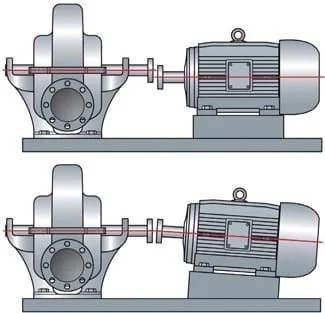In the analysis of anomalies in rotating equipment using spectra and time waveforms, abnormal vibration patterns recorded may not always be due to misalignment. In view of this, Kutsi Jaka, Product Manager: Condition Monitoring at SKF South Africa, states that it is advisable to carry out comprehensive tests that include techniques like phase analysis and others to ensure a conclusive result.
By Jimmy Swira
In condition-based maintenance programmes of heavy equipment, root cause analyses of potential faults, especially when a single method is applied, may not always provide accurate results. This could culminate in undetected faults and false positives/negatives.
Unfortunately, the ensuing misdiagnosis may lead to wrong interventions that could worsen the situation. This could cause what production teams dread the most – downtime.
Not uncommon
This is the situation the SKF South Africa team encounter when conducting condition-based maintenance for clients in the Southern African heavy industry, particularly rotating equipment like motors, turbines, and compressors. Sometimes, they notice that some clients, or contractors the clients engage, hastily assume that misalignment of rotating equipment is always the cause of abnormal vibration patterns.
“Generally, granted, in respect of statistics from our projects, misalignment is attributed to many cases of abnormal vibration, approximately 50 percent – which constitutes the single largest contributor to vibration related problems. However, in other cases, there could be other factors at play. And this is not uncommon,” states Kutsi Jaka, the Condition Monitoring Prod Manager at SKF South Africa. He singles out some of the common ones as imbalance, mechanical looseness, bend shafts, bearing wear, soft foot, and resonance. These may be due to situations where condition monitoring may not effectively unearth underlying causes.
Cases where vibration analysis may not be effective
Condition-based maintenance of rotating equipment using vibration analysis may not provide the expected or accurate outcome in the following scenarios:
i. Technical limitations
Vibration analysis, when used as the only tool in condition-based maintenance programmes, may not effectively detect some of the misalignment faults dependent on the type and design of the coupling or sheave, the misalignment type, and the speed of the application.
Jaka illustrates a case in point: “Spectra and time waveforms do not always provide a conclusive analysis result. There may be other faults present in the machine producing similar vibration patterns. Thus, for successful shaft/belt misalignment detection, other tools such as phase analysis, oil analysis (for gears), and thermography may be used to complement vibration monitoring.”
Typically, some of the faults that may not be detected and cause abnormal vibration levels include:
- Suction or discharge restrictions
- Dry running conditions in pumps that may cause seal failures
- Electric faults such as phase imbalances or insulation degradation in motors
- Loose rotor parts
Based on this, monitoring vibration levels alone overlooks these early signs, Jaka points out.“Vibration provides partial data on components like bearings or shafts. It may miss, in some cases, broader system interactions.”
ii. Implementation and operational difficulties
Ideally, when performing shaft alignment, the alignment heads need to be mounted directly on the shafts (not couplings) in order to achieve shaft-to-shaft alignment.
However, in reality, this is not always possible because of limited access on some applications. For instance, portable vibration tools may not access hard-to-reach components like conveyor belt bearings. Furthermore, in some cases, environmental factors such as transmitted vibration and laser interference, amongst others, may influence the alignment process and result.
Sometimes, periodic monitoring(scheduled) can miss evolving faults, leading to incomplete monitoring and undetected faults.
iii. Competency gaps among assigned personnel
It is assumed that all personnel assigned to conduct vibration analysis using tools have the required level of competence. However, this is not always the case, as some may not have the required proficiency in some instances.
For this reason, Jaka suggests that the personnel must constantly keep abreast of contemporary needs. “Alignment technicians and engineers are required to attend training on precision alignment using Dial Gauge Indicators and Laser Alignment methods. The training typically focuses on, among other topics, alignment preparation steps (pre-alignment checks), alignment methods, and alignment tolerances.”

A technician measuring equipment for potential misalignment (Image credits: Global Pumps)
Comprehensive analysis
On the whole, for accurate diagnosis, comprehensive analysis using other techniques should be implemented to deliver actionable data to inform effective interventions, Jaka advises, highlighting two steps.
Establishing the asset criticality matrix is the first step. “An asset criticality matrix will guide the personnel to determine the frequency of vibration data collection, the type of data acquisition devices (whether to use hand-held devices or online devices), and the vibration sensors.”
The second step would be to identify the measurement points and mark them for easier identification during data collection. This should then be followed by developing the assets in a condition monitoring database. The database will store data, manage thresholds and schedule compliance, and reporting.
The vibration parameter as part of comprehensive analysis
At the end of the day, the competent personnel applying a comprehensive plan need tools that have been tried, tested, and excelled in rugged applications. Thankfully, with advances in technology, they have a wide choice at their disposal. One of the tools that can be adopted is the vibration parameter, Jaka recommends.
“The vibration parameter is considered the best machine condition indicator to be used in a condition-based maintenance programme. It is applicable to the majority of failure modes in a typical heavy industry plant. The parameter covers over 80% of typical failure modes in a fixed plant. However, despite its effectiveness, this tool in vibration monitoring must be complemented by other tools such as oil analysis, infrared thermography, ultrasound, motor current signature analysis, and visual inspections, to name a few.”






